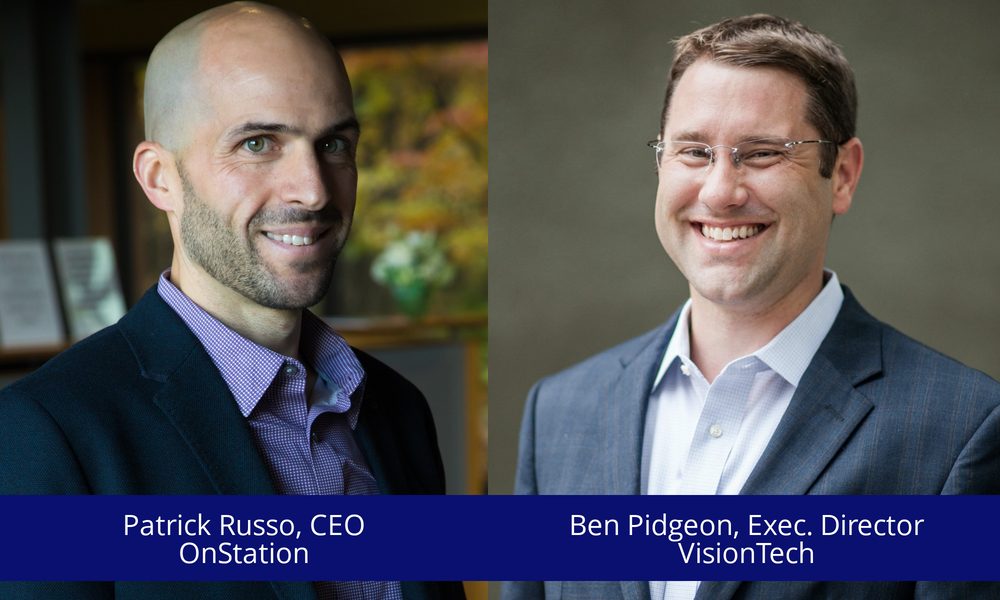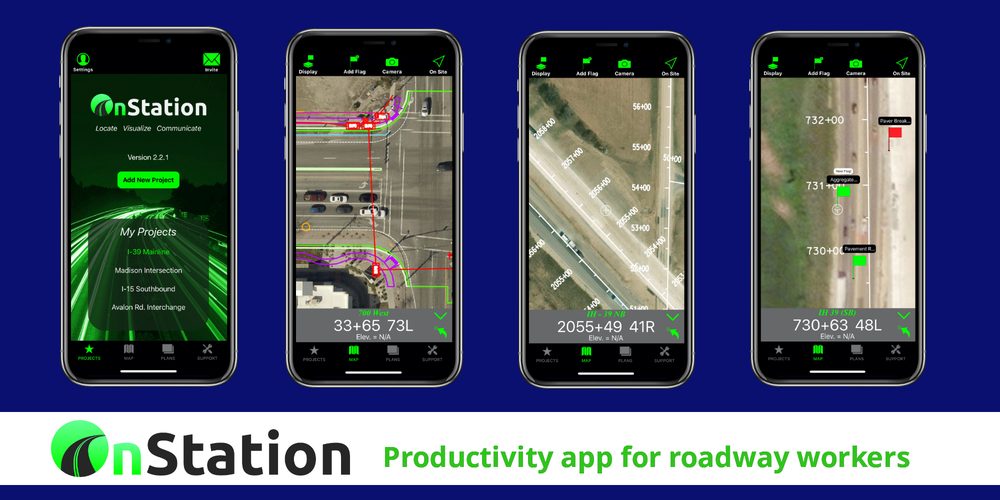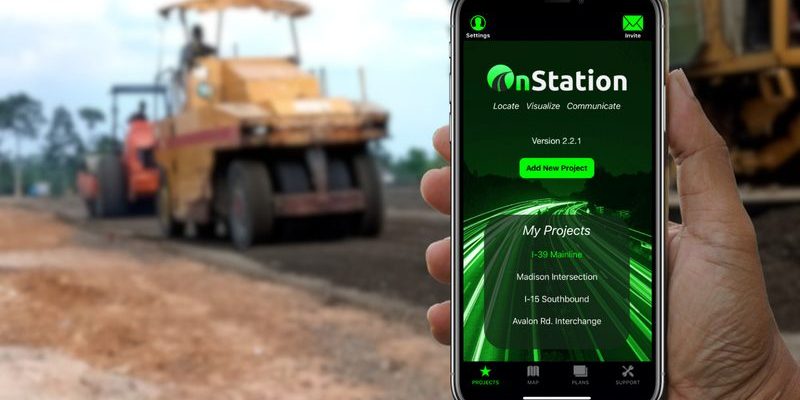Before meeting Patrick Russo, CEO of OnStation, one of our February Pitch presenters, I checked out his LinkedIn profile. Two things stood out: he’s a triathlete and a fulfiller of dreams. I have to admit I have no intention of competing in triathlons, but that fulfiller of dreams role sounded good. So I asked Patrick about it. After college, he moved out to Vail, Colorado, and started an upscale bakery specializing in wedding cakes. It was extremely successful business; Patrick and his partner created 100 cakes a summer. Brides were so happy, they cried – hence his unique job title. He exited the company and moved to Cleveland where he was a startup mentor at JumpStart before becoming CEO of a SaaS company called OnStation where he’s still exceeding expectations but on a much different stage, America’s roadways. VisionTech is impressed with how OnStation is disrupting the road construction market and with the company’s unlimited potential. Here’s a preview of Patrick’s pitch on February 25.

BP: How did you learn about VisionTech?
PR: OnStation was part of the Heritage Group’s Hard Tech Construction Accelerator Group last fall. The director, Scott Kraege, suggested I connect with VisionTech and here we are.
BP: Give me your OnStation elevator pitch.
PR: In a nutshell, OnStation is a custom mobile software development company for civil engineering. Our core offering is the mobile app OnStation for roadway workers that provides instant job site location, access to project design plans and contract documents, and a team chat platform. The goals are more efficient workflows, keeping cones off the road, traffic flowing, and work progressing. Ultimately, we want OnStation to be as common on roadway construction projects as hard hats.
BP: What’s OnStation’s backstory?
PR: OnStation is the brainchild of Jake Bailosky who worked as a project engineer at the Ohio Department of Transportation (DOT) and got first-hand experience with the day-to-day challenges of the job. Jake taught himself how to code and on nights and weekends, built the first generation of OnStation. What was really helpful was that during his last four years at the DOT, Jake sat on the technology review board and saw all of the tech the agency was considering. He saw holes in project management solutions and built OnStation as a complementary plugin to these larger solutions.
I joined OnStation two years ago after meeting Jake through JumpStart, which is Cleveland’s version of TechPoint, where I served as a mentor. I had experience starting and investing in companies, including the infamous wedding cake company, and was looking for an opportunity to turn an idea into a company. I was fortunate to meet Jake and join OnStation.
BP: You’ve done some pilots and field studies with state departments of transportation. How did they go?
PR: We’ve done projects with both the Wisconsin DOT and Utah DOT, which were both highly beneficial. We recently tested our Station Finder tool with the Wisconsin DOT, and they realized 6x in cost avoidance using this feature alone. If you’ve ever seen a plumber in your neighborhood, driving around trying to find a house, imagine what it’s like for DOT employees who have to find a specific guardrail to replace or pothole to fill. A lot of time is wasted looking for the right station—the industry term for location—on the job site.
BP: Who are your ideal customers?
PR: Anyone working on road projects in design, construction, and maintenance is a potential customer. So that includes engineering firms, construction companies, inspectors, state and local DOTs, and of course, road workers themselves. We’ve found that it’s easier to get into commercial construction companies as they’re more open to adopting new technology. Hopefully, seeing commercial companies and their employees using OnStation will pull DOTs onto our platform. Road workers are great advocates! We solve the daily issue of “Where am I going and what am I doing?” When your jobsite is eight miles long, that’s a big issue we solve in seconds.
BP: What’s your revenue model?
PR: Like most apps, we have a SaaS user-licensing model. Companies or DOTs can buy licenses and assign them to users within their workforce. There is an annual, recurring licensing fee.
BP: How big is the market?
PR: The global market for roadway construction and maintenance is over a billion dollars and hundreds of millions in the U.S. alone. If you look around, there are roadway projects happening all over, all the time. The universal problem is aging infrastructure and it needs to be replaced. Roadways are one market, but we see opportunities for OnStation in other essential assets like railways, water and sewer lines, oil and gas lines, and telecommunications.

BP: Has COVID-19 impacted the road construction world?
PR: COVID-19 put a kink in things early on in the shutdowns. Roadway projects are funded by the gas tax so a lot of states and municipalities put projects on pause. But here’s the thing: roads still need to be maintained. Some cities and states saw the slowdown in traffic as a great opportunity to work on major interstate projects. Here in Indy, it’s the I-69 Finish Line project; one we hope to be working on soon. As things get back to “normal,” we’ll see a pickup in road projects especially if Washington D.C. directs more funding to infrastructure projects like it’s promised.
BP: Any competitors?
PR: We don’t have any direct apples-to-apples competitors, but we’re not the only ones out there trying to tackle this. Mainly, there are bits and pieces of tech like project management for traditional construction and more complicated, expensive solutions for project mapping and stationing. No one is coming at it like OnStation, which is very much user focused, highly intuitive and easy to put to work. As I mentioned earlier, it really helps that Jake lived in the roadway construction world, knows what tech is out there and what the holes are.
BP: What kind of traction are you seeing?
PR: Currently, we have 65 active roadway projects in 15 states and 400 active users. In 2020, we saw nearly 85,000 interactions on our app. Given we had just release OnStation 2.0 in December 2019, we’re pretty pleased with this traction.
BP: What will this investment round be used for?
PR: Three things: team, traction and time. We want to add to our external and internal sales teams to sell and onboard customers. We also plan to hire a lead gen/marketing specialist and another senior developer. In terms of traction, we are developing enterprise level tools and a portal customers can use to access all of their projects on OnStation. This is increasingly important as we bring on larger commercial customers and DOTs. Finally, time. We need the funds to grow faster.
BP: Why should VisionTech investors back you?
PR: Three reasons. First, the quality of America’s roads is a D. It’s a problem that’s not going away; interstates, state highways, city streets all need to be maintained and built. We bring efficiency, saving time and money, to this ongoing challenge. Second, to attract a younger workforce that lives on their smart phones, the industry needs to be tech-enabled. We do that. I just had a conversation with a younger guy who told me he uses OnStation every day and loves it. Finally, we have the very real opportunity to be the industry standard for private construction companies as well as DOTs. And while DOTs are hard business to win, once you’re in, those contracts are hard to break.
To learn more about OnStation, visit their website. VisionTech Angels’ February Pitch Events will be virtual on Tuesday, February 23 and Thursday, February 25 at 6 p.m. Pitch events are open to our members and accredited investors interested in joining our group. To register, check your email for an invitation, go to our Events page or email Ben Pidgeon at bpidgeon@visiontech-partners.com.

